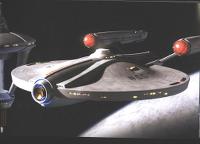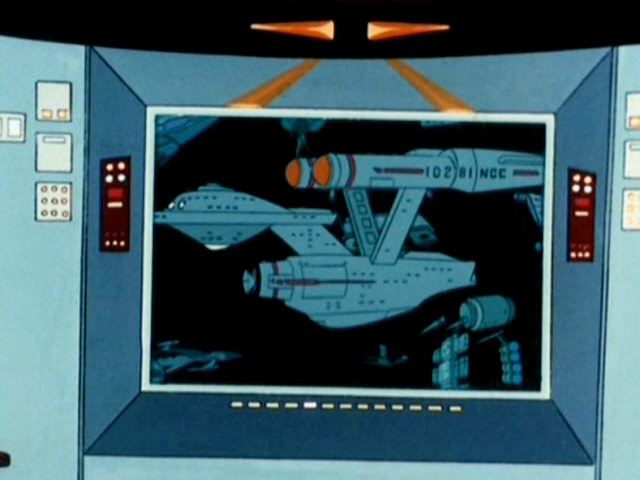I ran across yet another thread where the TAS Bonaventure design was getting trashed, and it started me thinking... hmmm.. is there a way to do a reasonably faithful version of that ship and have it look "right?"
Now, there have been a number of "total revisitations" to the Bonaventure design, including this one from the TNG Encyclopedia:

... and this one from the "Ships of the Line" series:

But the ORIGINAL shot of the ship looked like this:

Some enterprising fans put together the following "cleaned up" views, basically being faithful to the original presentation:


Also, some of you may have noticed that some of Aridas' recent work uses the general nacelle configuration on this ship, which also got me to thinking about this.
Now, in the TAS episode in question, the crew of the Enterprise finds this ship, lost in the "Delta Triangle." It's commented that this was the "first ship with Warp Drive."
This goes along with my personal supposition that Warp Drive is just an outgrowth of the prior FTL propulsion system which used a static subspace bubble and, inside of that bubble, conventional impulse drive, to allow a ship to reach speeds equivalent to WF4.2 (TOS scale). At some point, one of these ships ended up "rippling" it's subspace bubble, and discovered (probably quite by accident) the basis of "warp drive" as it's known in TOS times... or as Jose Tyler tells us, after the "time barrier" has been broken.
So, the Bonaventure is (in this interpretation) a much closer ship to the TOS era than we might expect, basically predating "The Cage" by only a few decades. She's a much smaller ship, however, just as described in the image above.
I've basically been trying to figure out how to put a functional spacecraft into the general configuration seen in the TAS episode, but I'm allowing myself to take some liberties along the way. The images below will show my progress so far.
(Note that I've only created a primary hull so far, and even that is not entirely complete yet.)
First, here are some basic orthographic images of the p-hull:





The boxes on the topside will be reflected on the bottom as well, and are external equipment boxes holding sensor equipment. The domes, top and bottom, hold rotating sensor hardware as well.
There are two big white circles on the front of the animate ship shot... I decided that those are forward scanners (much like the three on the leading edge of the TOS Enterprise), but they're cruder and bulkier. I MIGHT decide to "shave down" the sockets... but I sort of like it how it is for now (your thoughts are solicited! )
)
The impulse deck is intended to resemble a blend between the TOS design and... yes... the ENT design. I actually sort of like how this turned out, too.
I'm debating weapons systems... and leaning towards a "behind the hatches" concept much like the NX-01 used, but a bit larger in relation to the ship when deployed.
To give you a sense of scale, and general layout, here's a section view of the primary hull:

And to wrap it up for tonight, here are a couple of perspective views. Considering that I've been reasonably faithful to the general layout from TAS, I'm pleasantly surprised how nice these views look to me so far. Then again, I'm close to the topic, so (as with everything) I'm anxious to hear what you guys think.


I'd love to hear what you guys think of my approach!
Now, there have been a number of "total revisitations" to the Bonaventure design, including this one from the TNG Encyclopedia:

... and this one from the "Ships of the Line" series:

But the ORIGINAL shot of the ship looked like this:

Some enterprising fans put together the following "cleaned up" views, basically being faithful to the original presentation:


Also, some of you may have noticed that some of Aridas' recent work uses the general nacelle configuration on this ship, which also got me to thinking about this.
Now, in the TAS episode in question, the crew of the Enterprise finds this ship, lost in the "Delta Triangle." It's commented that this was the "first ship with Warp Drive."
This goes along with my personal supposition that Warp Drive is just an outgrowth of the prior FTL propulsion system which used a static subspace bubble and, inside of that bubble, conventional impulse drive, to allow a ship to reach speeds equivalent to WF4.2 (TOS scale). At some point, one of these ships ended up "rippling" it's subspace bubble, and discovered (probably quite by accident) the basis of "warp drive" as it's known in TOS times... or as Jose Tyler tells us, after the "time barrier" has been broken.
So, the Bonaventure is (in this interpretation) a much closer ship to the TOS era than we might expect, basically predating "The Cage" by only a few decades. She's a much smaller ship, however, just as described in the image above.
I've basically been trying to figure out how to put a functional spacecraft into the general configuration seen in the TAS episode, but I'm allowing myself to take some liberties along the way. The images below will show my progress so far.
(Note that I've only created a primary hull so far, and even that is not entirely complete yet.)
First, here are some basic orthographic images of the p-hull:





The boxes on the topside will be reflected on the bottom as well, and are external equipment boxes holding sensor equipment. The domes, top and bottom, hold rotating sensor hardware as well.
There are two big white circles on the front of the animate ship shot... I decided that those are forward scanners (much like the three on the leading edge of the TOS Enterprise), but they're cruder and bulkier. I MIGHT decide to "shave down" the sockets... but I sort of like it how it is for now (your thoughts are solicited!
 )
)The impulse deck is intended to resemble a blend between the TOS design and... yes... the ENT design. I actually sort of like how this turned out, too.
I'm debating weapons systems... and leaning towards a "behind the hatches" concept much like the NX-01 used, but a bit larger in relation to the ship when deployed.
To give you a sense of scale, and general layout, here's a section view of the primary hull:

And to wrap it up for tonight, here are a couple of perspective views. Considering that I've been reasonably faithful to the general layout from TAS, I'm pleasantly surprised how nice these views look to me so far. Then again, I'm close to the topic, so (as with everything) I'm anxious to hear what you guys think.


I'd love to hear what you guys think of my approach!






